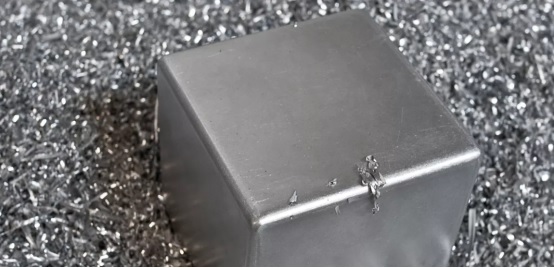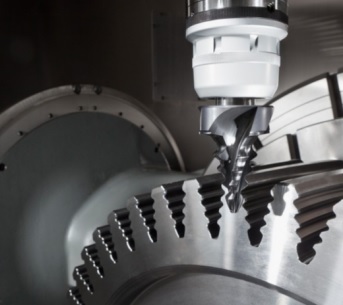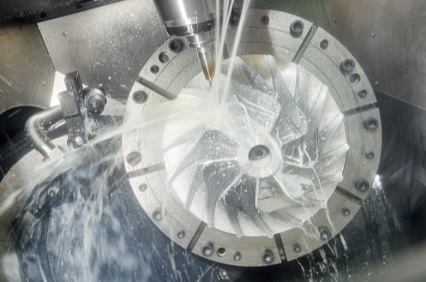Stainless Steel Milling
As a special material, stainless steel has the characteristics of high-temperature resistance and corrosion resistance. It is generally considered to be sticky and hard during processing, making it difficult to mill. In this article, we are going to talk about features of stainless steel milling, and ways to stainless steel milling.

Features of stainless steel milling
1. Serious work hardening
What is work hardening ? During processing, due to plastic deformation of the processed surface, the strength and hardness increase, and the phenomenon of plasticity and toughness decrease is called work hardening.
The work hardening of stainless steel is serious, especially a mixture of austenite and ferrite. The hardness of the hardened layer is 1.4~2.2 times higher than the original matrix hardness, and the strength R=1470~1960MPa. This type of stainless steel has high plasticity and a large strengthening coefficient. Moreover, austenite is unstable and easily transformed into martensite under the action of cutting force.
2. Large cutting force
Stainless steel has high plasticity, especially the depth of austenitic stainless steel, which is 2.5 times that of C45 steel. During the milling process, the plastic deformation is large, and the cutting force is increased. The work hardening is serious, the heat strength is high, and the cutting curl and breaking are difficult.
3. High cutting temperature
The plastic deformation of stainless steel is large, the friction is increased, and its thermal conductivity is relatively low. Therefore, under the same conditions, the temperature of milling stainless steel is about 200 degrees higher than that of C45 steel.
4. Cutting is not easy to break
When processing stainless steel, it is easy to stick and generate a built-up edge. The plasticity and toughness of stainless steel are relatively large, and the chips are not easy to break when milling. Under high temperature and high pressure, the tool is prone to bond wear and built-up edge.
5. The tool is easy to wear
Of course, stainless steel milling cutters are used for processing stainless steel, because the TiC hard point of stainless steel is easy to cause sharp wear and tear of the cutter. Under high-speed, high-temperature and high-pressure conditions, cutting and cutting tools are prone to bonding, spreading and crescent wear.
Ways to stainless steel milling
The above are the characteristics of stainless steel milling. Under such circumstances, how should we mill stainless steel?
1. Tool selection
Tool material
Either high speed steel (HSS) or cemented carbide tools can be used for machining stainless steels.
High speed steels: Either tungsten or molybdenum HSS can be used. These are particularly useful in machining operations involving high feed and low speed machining operations where there are variable cutting edge stresses induced from complex tool shapes.
The tungsten types (eg. T15) can be useful for their good abrasion resistance and red hardness. The molybdenum HSS are more widely used, M42 being useful for applications such as milling cutters where a good combination of hardness and strength are required at lower cutting speeds. M42 has better hardness than grades like the more common M2, but may not be as tough however.
If the tools are prone to edge chipping, use a tougher grade, eg. M2, M10 If tools are burning, use a higher red hardness grade, eg. M42, T15 If the tools are wearing, use a more abrasion resistant grade, eg. T15
Cemented carbides: Cemented carbides are normally used for machining stainless steels where higher speeds or higher feeds than those that can be produced using HSS are required. Either disposable insert or brazed-on tips (where lower cutting speeds can be tolerated) can be used and are composed of either tungsten carbides or a blend of tungsten and other metal carbides, including titanium, niobium, and chromium. The carbides are bonded with cobalt. The 'straight' tungsten carbides grades are used for machining austenitic and duplex stainless steels and the 'complex' carbides are used for machining martensitic and ferritic family grades.
Coated carbides have the additional benefit of improved wear resistance and resistance to breakage. Consequently they are capable of higher cutting speeds compared to un-coated carbide tools.
The wide range of carbide tools available usually means that machining trials are needed to get the optimum machining characteristics for specific situations.

Tool geometry and sharpness
It is essential to keep the cutting tools sharp when machining stainless steel. Careful grinding and honing of the tool faces to give accurate and sharp face angles is important.
This helps optimize:
tool life
finish, accuracy and tolerances
productivity between regrinds
and reduce:
tool breakages
power requirements
Re-sharpening should be done as soon as the quality of the cut has deteriorated.
Machine grinding using properly dressed wheels, free from glazing, is preferable to hand grinding to get the necessary accuracy of tool geometry.
Correct tool geometry is important for minimizing swarf build up on the tool faces.
Swarf build up can also result in increased machine power requirements and poor surface finish on the machined surfaces.
Tool relief angles must be flat. Concave relief faces can result in tool chipping or breakage due to the reduced support of the cutting edge.
Where possible the tool faces should incorporate chip curlers or breakers as austenitic stainless steels are prone to forming long spiraling turnings that can easily wrap around the tool and tool post. These can easily become entangled around the tooling and are difficult and time-consuming to remove. In extreme cases, the tool can become jammed by entangled turnings.
2. Lubrication and cooling
It is essential that cutting fluids are used when stainless steel is machined. This is due to the combined effects of the deep cuts and high feed rates needed to overcome the effects of work hardening, and the low thermal conductivity of the austenitic stainless steels, restricting the flow of heat away from the machined faces. Overheating stainless steel surfaces, characterized by the formation of heat tinting colors, during machining can impair corrosion resistance and so must be avoided. If formed pickling the surface can be used to restore corrosion resistance on the finished part. Overheating can also result in distortion that can be difficult to compensate for or correct.

The lubrication provided by cutting fluids also helps reduce tool wear and wash away the machining swarf.
Generally cooling is more important than lubrication with faster the cutting speeds and so high cutting fluid flow rates are normally used when machining stainless steel.
Either mineral oils or water-soluble emulsifiable oils can be used. Mineral oils are more suited to severe machining operations with heavy loads at low speeds or where HSS tools are being used. Emulsifiable oils are used for machining at higher speeds with carbide tooling.
Mineral oils:Sulphurized, chlorinated or sulpho-chlorinated mineral oils can be used with additions of up to 10% fatty oils for machining non-free machining grades. Paraffin is used to dilute these oils, in oil/paraffin ratios between 1/5 for high speeds and light feed work to 1/1 for slower speed and heavier feed machining.
If excessive wear is being experienced, consider using greater dilutions. If the cutting edge is tending to burn, consider reducing the dilution.
Emulsifiable oils:These oils are diluted with water and provide better cooling than the paraffin diluted mineral oils. If extreme pressure (EP) emulsifiable oils are used, more severe machining operations can be supported. It is important that dilution is done by adding oil to water, not water to oil so that the correct form of an emulsion, with the right lubrication and cooling properties, is formed.
After machining all traces of the cutting fluid should be removed from the surface so that the stainless steel surfaces can self-passivate. Under certain circumstances, acid passivation should be considered.
3. Running Parameters
While tool selection is a critical step to more effective machining, dialing in the proper running parameters is equally important. There are many factors that go into determining the running parameters for stainless steel machining, but there are some general guidelines to follow as a starting point.
Generally speaking, when machining stainless steels a SFM of between 100-350 is recommended, with a chip load ranging between .0005” for a 1/8” end mill up to .006” for a 1” end mill.
The milling speed of the stainless steel milling cutter made of cemented carbide should be 40~60m/min. In order to avoid cutting of the cutting edge in the hardened layer and accelerate tool wear, the feed should be greater than 0.1mm.
In short, when we process stainless steel, a material with poor machinability, we can change the processing environment through tool selection, cutting fluid use, and parameter settings. I hope these will help you.


